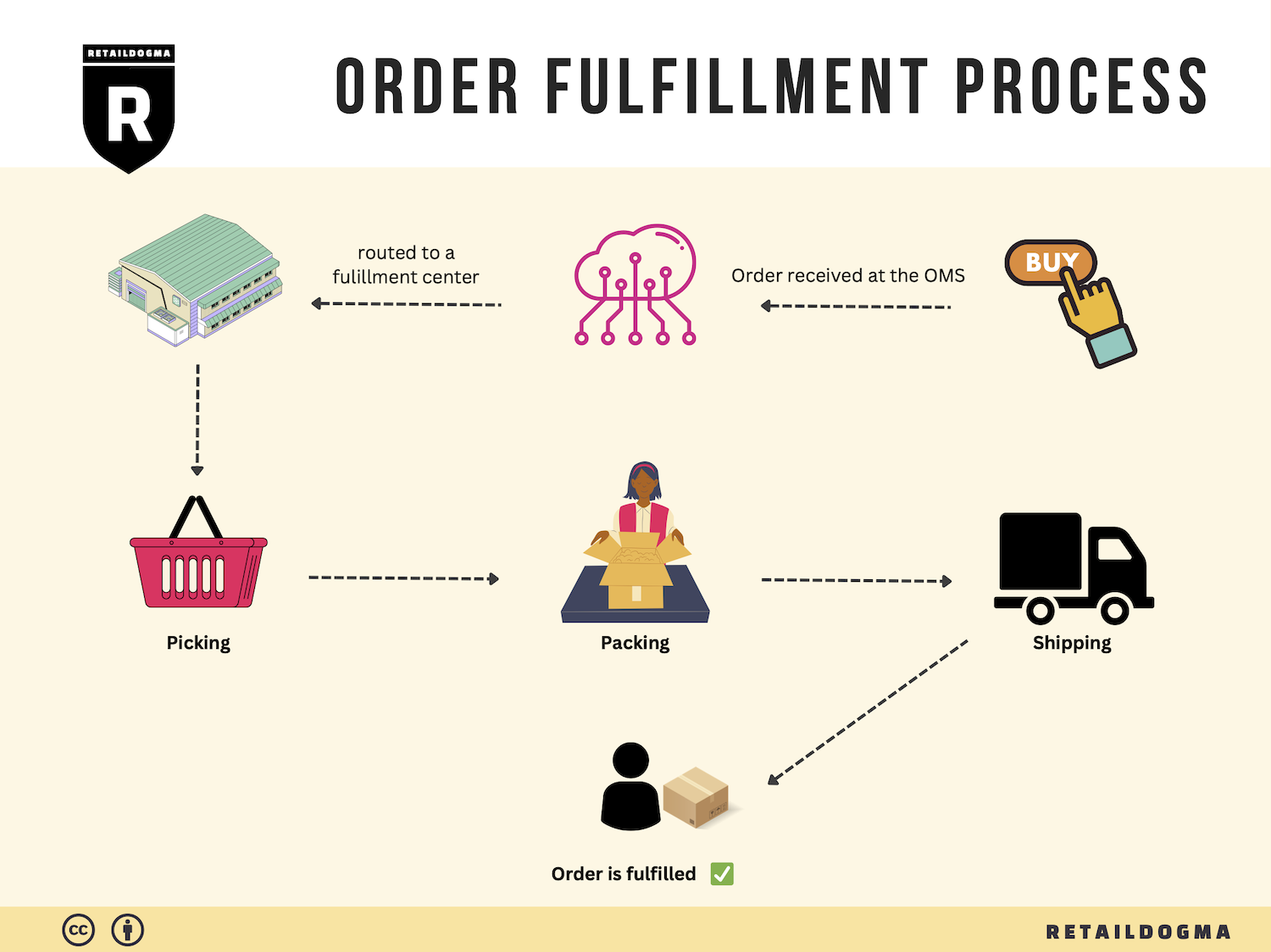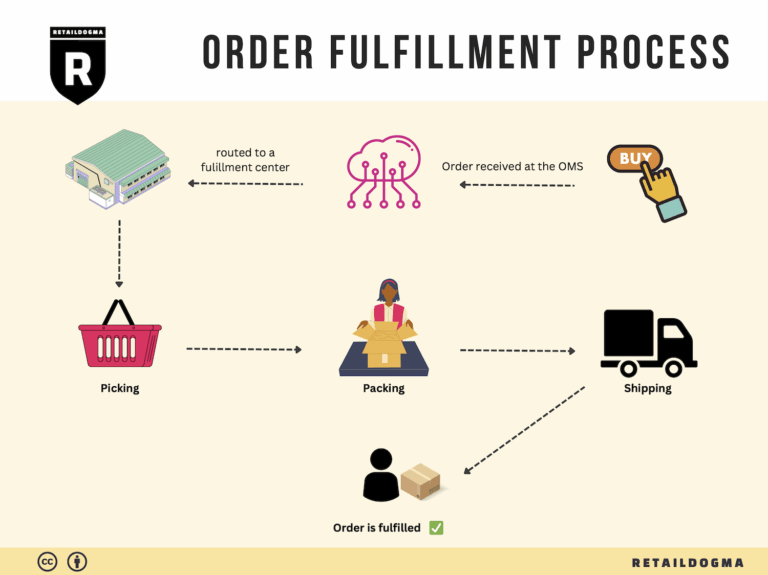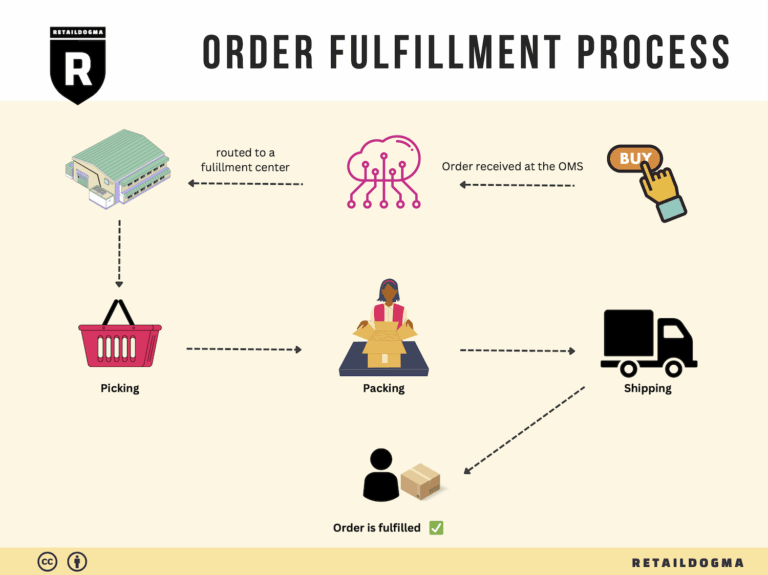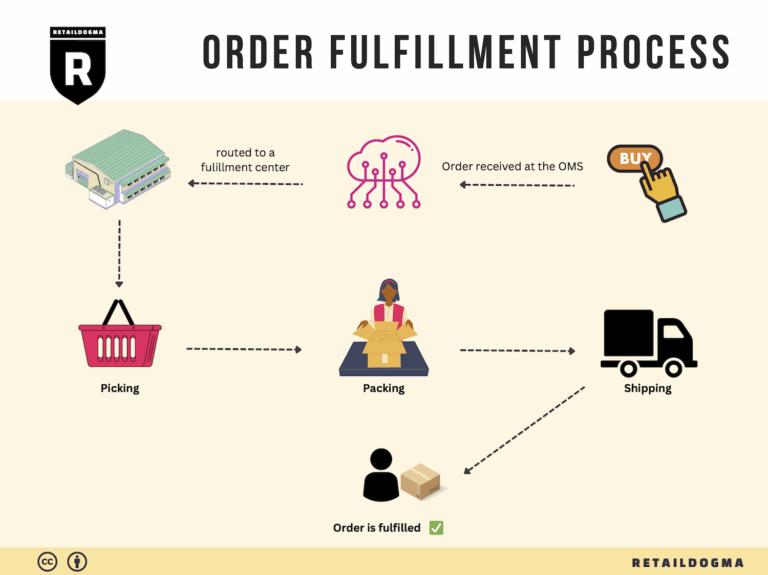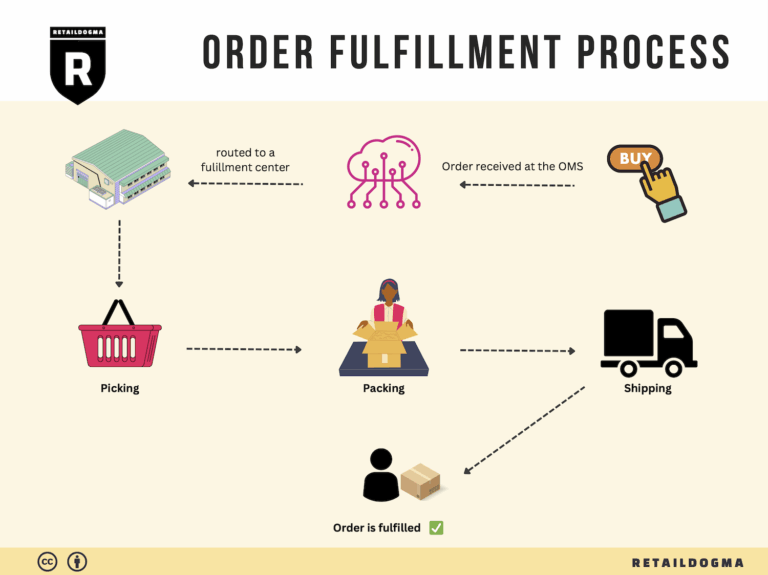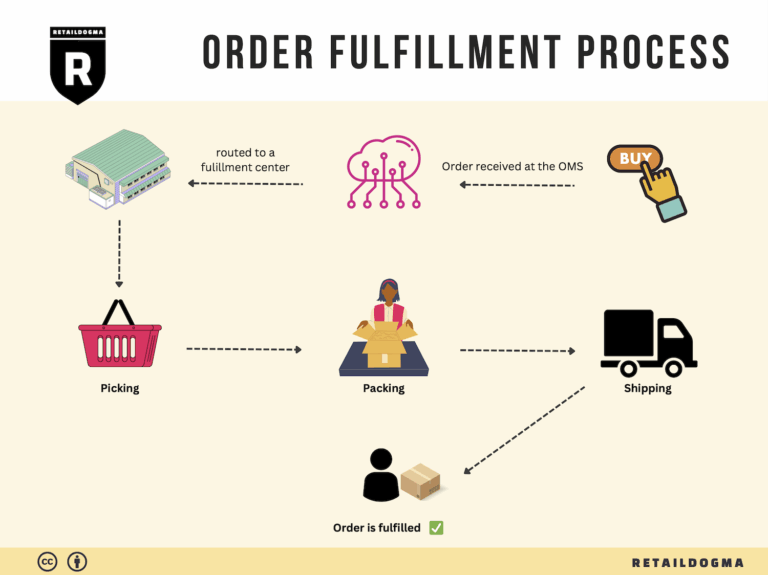What Is A Fulfillment Center? A Complete Guide (2025)
What is E-commerce Fulfillment? An Introduction for Growing Businesses
Understanding E-commerce Fulfillment: A Key Component for Growing Businesses
As your e-commerce business begins to scale, the excitement of increased sales can quickly turn into a daunting challenge—especially when it comes to packing and shipping orders. Many entrepreneurs find themselves overwhelmed by the logistical demands of fulfilling customer orders efficiently and accurately. The fulfillment process is crucial; it encompasses everything from receiving inventory to packing products and shipping them directly to customers’ doorsteps. If not managed properly, it can lead to delays, increased costs, and ultimately dissatisfied customers.
In this guide, we will demystify the concept of e-commerce fulfillment and provide you with the knowledge needed to make informed decisions about your logistics operations. We will explore various fulfillment models, such as Third-Party Logistics (3PL) and Fulfillment by Amazon (FBA), helping you understand the pros and cons of each option. This knowledge is essential for selecting a fulfillment strategy that aligns with your business goals and customer expectations.
We will also delve into the core services typically offered by fulfillment partners, including inventory management, order processing, packaging, shipping, and returns management. Understanding these services will help you identify what you need from a fulfillment partner and how they can enhance your operations.
Choosing the right fulfillment partner is critical to your success. We will provide practical tips on evaluating potential partners, including assessing their technology capabilities, service offerings, and customer service standards. Pricing is another crucial aspect we will cover, as understanding the cost structures associated with different fulfillment options will empower you to budget effectively and maximize your profit margins.
Ultimately, this guide aims to equip you with the insights and tools necessary to navigate the complexities of e-commerce fulfillment. By making informed decisions about your logistics strategy, you can streamline your operations, enhance customer satisfaction, and set your business up for sustainable growth. Whether you’re just starting or looking to optimize your existing fulfillment process, this resource will serve as your roadmap to success in the competitive e-commerce landscape.
What You’ll Learn In This Guide
- What is E-commerce Fulfillment? An Introduction for Growing Businesses
- The Order Fulfillment Process: From ‘Buy’ Button to Customer’s Door
- Comparing Fulfillment Models: In-House vs. 3PL vs. Dropshipping
- A Deep Dive into Amazon FBA: Pros, Cons, and Who It’s For
- Core Services Offered by Fulfillment Centers
- How to Choose a Fulfillment Partner: A 6-Point Checklist
- Understanding Fulfillment Pricing: A Breakdown of Common Fees
- Frequently Asked Questions (FAQs) about Fulfillment
- Conclusion: Is Outsourcing Fulfillment the Right Move for Your Business?
- Important Disclaimer
The Order Fulfillment Process: From ‘Buy’ Button to Customer’s Door
1. Receiving Inventory
The order fulfillment process begins with receiving inventory at the fulfillment center. This step involves the acceptance of goods from suppliers, which are then checked for quantity and quality against purchase orders. Each item is assigned a Stock Keeping Unit (SKU), a unique identifier that facilitates tracking throughout the supply chain.
Importance: Efficient inventory receiving is crucial because it ensures that the fulfillment center has the correct products available for future orders. Errors at this stage can lead to stock discrepancies, which can cause delays and customer dissatisfaction. A well-organized receiving process minimizes these risks and sets the foundation for effective inventory management.
2. Warehouse Storage
Once inventory is received and verified, the next step is warehouse storage. Products are systematically organized and stored in designated locations within the fulfillment center. This involves categorizing items based on their SKU and placing them in accessible areas to streamline future picking.
Importance: Proper warehouse storage optimizes space and improves the speed of order fulfillment. By implementing an effective storage strategy, businesses can reduce the time employees spend searching for products, thus enhancing overall operational efficiency. Key terms associated with this step include “bin location” and “inventory turnover,” which are essential for maintaining an organized and efficient storage system.
3. Order Picking
When a customer places an order, the fulfillment center initiates the order picking process. This involves selecting the correct items from storage based on a pick list, which details the SKUs and quantities required for each order. Advanced technologies, such as robots and conveyor systems, can assist in this process, making it faster and more accurate.
Importance: Order picking is critical as it directly impacts order accuracy and fulfillment speed. Mistakes during picking can lead to incorrect shipments, resulting in returns and dissatisfied customers. By utilizing pick lists and automation, businesses can significantly enhance their picking accuracy and efficiency, thereby improving customer satisfaction and reducing operational costs.
4. Order Packing
After items are picked, they are transported to the packing station, where they are prepared for shipment. During this step, items are carefully packaged, labeled, and documented. This includes determining the appropriate packaging materials to protect the products during transit, as well as ensuring that shipping labels include accurate tracking information.
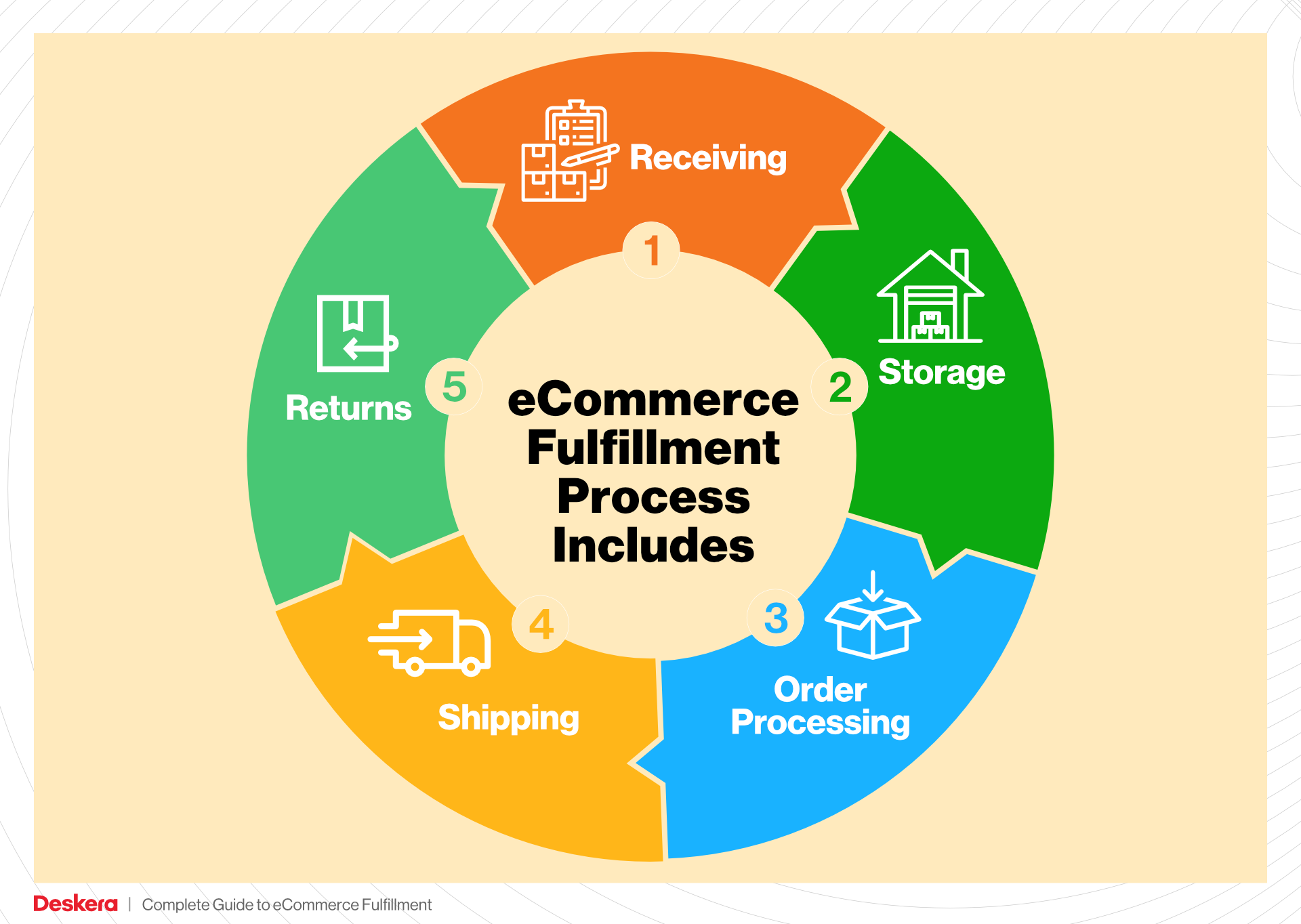
Importance: Effective order packing is essential for protecting items during shipping and providing customers with accurate tracking information. A well-packaged order can reduce damage during transit, leading to lower return rates and improved customer satisfaction. Key terms relevant to this stage include “packaging materials” and “shipping manifest,” both of which are vital for ensuring a smooth shipping process.
5. Shipping & Delivery
The final step in the order fulfillment process is shipping and delivery. Once orders are packed, they are handed over to shipping carriers for distribution to customers. The fulfillment center monitors the shipment process, providing tracking updates to customers to enhance transparency and trust.
Importance: Timely shipping and delivery are paramount in e-commerce, as they directly influence customer satisfaction and loyalty. Fast and reliable delivery services can differentiate a business in a competitive market. Important terms associated with this step include “last-mile delivery” and “shipping carriers,” which are critical for understanding the logistics involved in getting products from the fulfillment center to the customer’s doorstep.
In summary, mastering each step of the order fulfillment process is vital for e-commerce businesses looking to scale efficiently. By focusing on receiving inventory, warehouse storage, order picking, order packing, and shipping & delivery, companies can streamline their operations, enhance customer satisfaction, and ultimately drive sales growth.
Comparing Fulfillment Models: In-House vs. 3PL vs. Dropshipping
Fulfillment Model Comparison
| Model | Who Handles Inventory | Best For (Business Stage) | Key Advantage | Key Disadvantage |
|---|---|---|---|---|
| In-House Fulfillment | The business itself | Established businesses with stable sales | Greater control over operations and branding | Higher overhead costs and complexity |
| Third-Party Logistics (3PL) | A specialized logistics company | Growing businesses scaling operations | Cost-effective scalability and expertise | Less control over fulfillment process |
| Dropshipping | Suppliers or manufacturers | Startups and small businesses | Minimal upfront investment and risk | Lower profit margins and limited control |
In-House Fulfillment
In-house fulfillment refers to the process where a business manages its inventory, warehousing, and order fulfillment independently. This model is best suited for established businesses that have a steady stream of sales and sufficient capital to invest in logistics. The key advantage of in-house fulfillment is the level of control it provides over the entire fulfillment process. Businesses can customize packaging, ensure quality control, and implement their own operational processes, which can enhance brand identity and customer experience. However, this model comes with significant disadvantages, including higher overhead costs. Managing a warehouse, hiring staff, and maintaining inventory requires substantial investment, both financially and in terms of time. Additionally, the complexity of logistics can overwhelm businesses that are not prepared for the demands of warehousing and fulfillment.
Third-Party Logistics (3PL)
Third-party logistics (3PL) involves outsourcing fulfillment operations to a specialized logistics provider. This model is particularly advantageous for growing businesses that are looking to scale operations without the burden of managing logistics internally. 3PL providers offer a wealth of expertise, advanced technology, and established networks that can enhance fulfillment efficiency. The key advantage of using a 3PL is cost-effective scalability; businesses can expand their reach without investing heavily in infrastructure. For instance, a company can leverage a 3PL’s existing warehouses and distribution centers, like the Amazon fulfillment center in Tallahassee, which processes over 200,000 packages daily, enabling quicker deliveries to customers. However, the trade-off is a loss of control over the fulfillment process. Businesses may face challenges in maintaining their brand’s standards and ensuring quality control, as they rely on an external partner to handle these critical aspects.
Dropshipping
Dropshipping is a fulfillment model where a business sells products without holding inventory. Instead, when a customer makes a purchase, the business orders the product from a third-party supplier who ships it directly to the customer. This model is ideal for startups and small businesses that want to minimize risk and investment. The primary advantage of dropshipping is the minimal upfront investment required; businesses can operate without the costs associated with inventory management or warehousing. Additionally, dropshipping allows for a broad product range without the need for physical stock, making it easier to test new markets and trends. However, dropshipping comes with significant drawbacks, particularly in terms of profit margins and control. Since the business relies on suppliers for inventory and fulfillment, it may face delays and inconsistencies that can harm customer satisfaction. Furthermore, profit margins in dropshipping are typically lower than in other models, as businesses must compete with suppliers and manage shipping costs while providing competitive pricing to customers.
Conclusion
Choosing the right fulfillment model is crucial for e-commerce businesses aiming to scale their operations effectively. In-house fulfillment provides control but at a higher cost, while 3PL offers scalability and expertise but may sacrifice some level of control. Dropshipping presents a low-risk entry point for new businesses, though it comes with lower profit margins and potential fulfillment challenges. As each model has its own set of advantages and disadvantages, business owners must carefully consider their specific needs, resources, and growth objectives when selecting the most appropriate fulfillment strategy.
A Deep Dive into Amazon FBA: Pros, Cons, and Who It’s For
Understanding Fulfillment by Amazon (FBA)
Fulfillment by Amazon (FBA) is a service provided by Amazon that allows sellers to store their products in Amazon’s fulfillment centers. Amazon then takes care of storage, packaging, and shipping to customers, as well as customer service and returns. This service is designed to help sellers scale their e-commerce businesses by leveraging Amazon’s extensive logistics network and customer base.
How FBA Works
-
Inventory Storage: Sellers send their products to Amazon’s fulfillment centers, where they are stored until sold. The seller is responsible for shipping their inventory to Amazon, which can be done in bulk or through smaller shipments based on demand.
-
Order Processing: When a customer places an order for a product listed through FBA, Amazon handles the entire fulfillment process. This includes picking the product from the warehouse, packing it, and shipping it directly to the customer.
-
Customer Service: Amazon provides 24/7 customer service for FBA orders. This means that any inquiries or issues regarding shipping, returns, or refunds are managed by Amazon, allowing sellers to focus on other aspects of their business.
-
Returns Management: FBA also manages returns for sellers, handling the logistics of returning items and processing refunds, which can be a complex and time-consuming task for individual sellers.
-
Multi-Channel Fulfillment: Beyond Amazon.com, sellers can use FBA to fulfill orders from their own websites and other platforms, making it a versatile solution for e-commerce businesses.
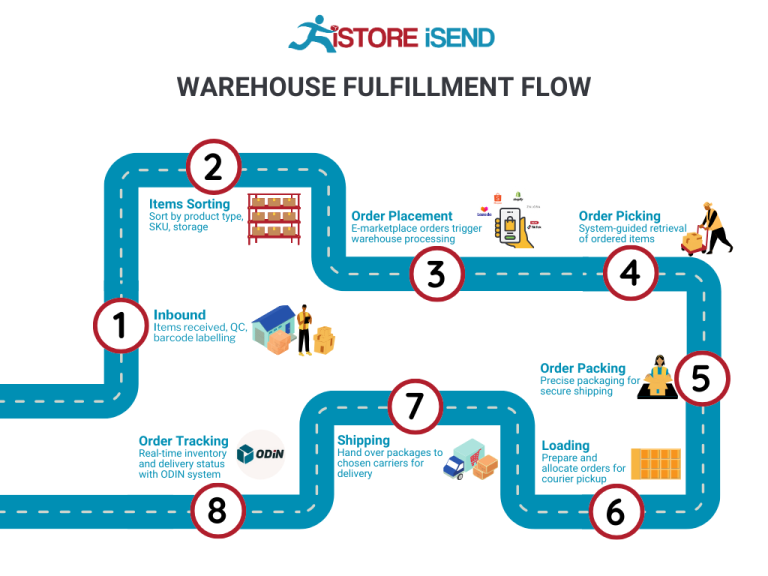
Pros of Using FBA
-
Prime Eligibility: Products fulfilled by Amazon are eligible for Amazon Prime, which can significantly increase visibility and sales. Prime members are more likely to purchase items that offer fast, free shipping.
-
Customer Trust: Leveraging Amazon’s brand reputation can enhance customer trust. Many buyers feel more secure purchasing from FBA sellers due to Amazon’s robust return policies and customer service.
-
Streamlined Logistics: FBA simplifies logistics for sellers. With Amazon handling storage, packing, and shipping, sellers can save time and reduce the complexities of order fulfillment.
-
Scalability: As demand grows, FBA allows sellers to scale their operations without the need for additional warehousing or logistics management. This is particularly beneficial during peak seasons like holidays or sales events.
-
Multi-Channel Fulfillment: FBA enables sellers to fulfill orders from various sales channels, not just Amazon. This capability allows for a more integrated approach to e-commerce, helping sellers reach customers wherever they shop.
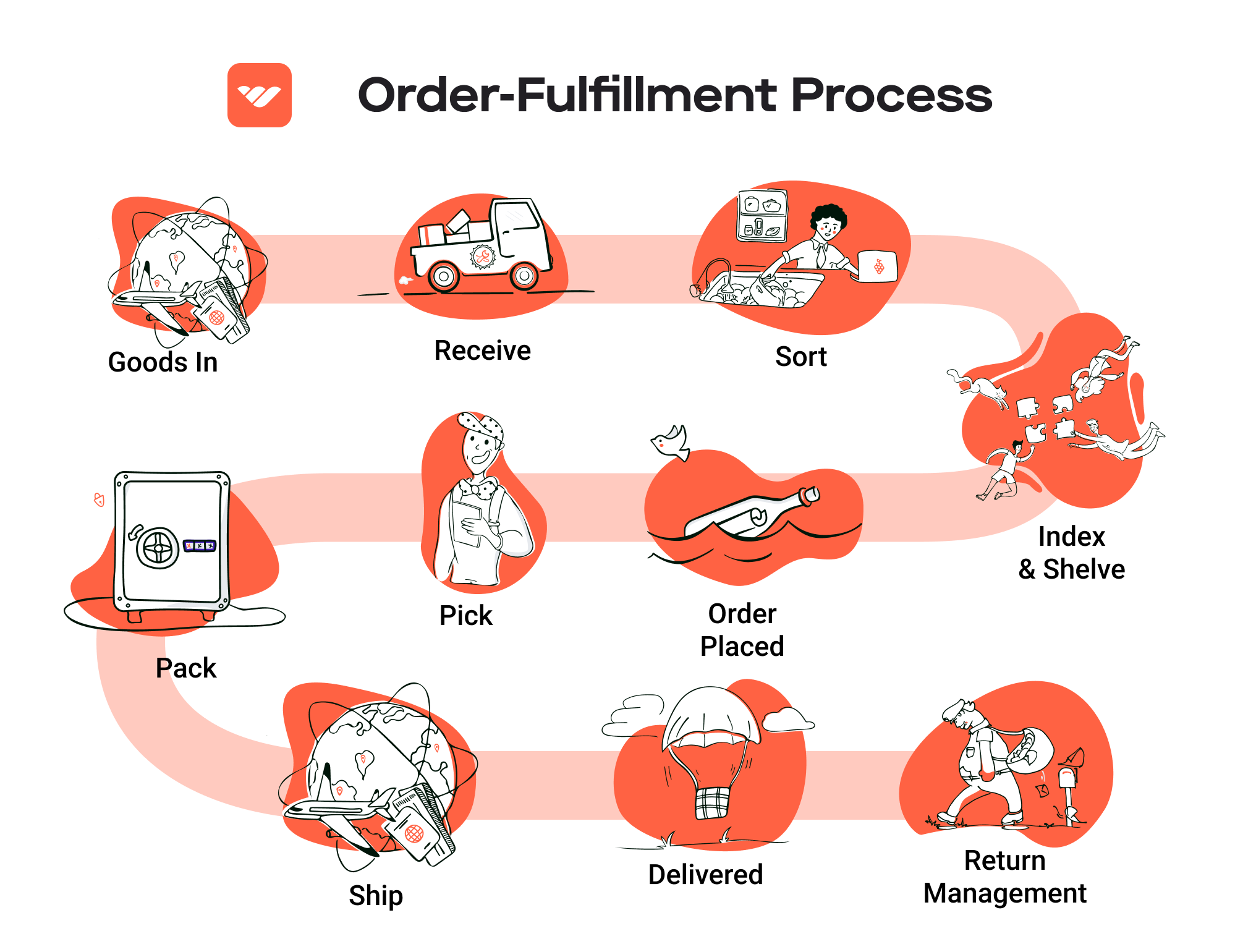
-
Advanced Analytics: Sellers using FBA have access to Amazon’s analytics tools, providing valuable insights into sales performance, inventory management, and customer behavior.
Cons of Using FBA
-
High Fees: FBA comes with various fees, including storage fees and fulfillment fees that can add up quickly. These costs can eat into profit margins, especially for lower-priced items.
-
Strict Inventory Rules: Amazon has stringent inventory management policies. Sellers must adhere to specific guidelines regarding inventory levels and product conditions, which can be challenging for those new to the platform.
-
Commingling Risks: FBA products may be commingled with other sellers’ inventory, meaning that customers may receive products from different sellers. This can lead to issues with quality control and brand reputation if not managed carefully.
-
Limited Control: By using FBA, sellers give up some control over their fulfillment process. This can be concerning for sellers who prefer to manage their own logistics and customer interactions.
-
Potential for Stockouts: If a seller does not manage their inventory effectively, they may run out of stock, which can lead to lost sales and negative impacts on their seller metrics.
-
Geographic Limitations: While Amazon has a vast network, FBA may not be the best option for sellers targeting international markets, as fulfillment costs and logistics can vary significantly.
Who is FBA Best For?
Fulfillment by Amazon is particularly well-suited for:
-
Small to Medium-Sized Businesses: Companies looking to scale quickly without investing in their own logistics infrastructure can benefit greatly from FBA.
-
Sellers with High Volume Products: For sellers with products that have consistent demand, FBA can streamline operations and help maintain inventory levels.
-
E-commerce Entrepreneurs: New sellers who want to leverage Amazon’s infrastructure and customer base can find FBA to be a valuable tool for growth.
-
Brands Seeking Prime Access: Businesses that want to reach Amazon’s Prime customer base and enhance their credibility can gain significant advantages through FBA.
-
Multi-Channel Sellers: Sellers who operate on multiple platforms and want a unified fulfillment strategy will find FBA’s multi-channel capabilities beneficial.
In conclusion, while Fulfillment by Amazon offers substantial advantages in terms of logistics, customer trust, and scalability, it is essential for sellers to weigh these benefits against the potential downsides such as fees and inventory management challenges. By assessing their business model and goals, e-commerce entrepreneurs can determine if FBA is the right fit for their growth strategy.
Core Services Offered by Fulfillment Centers
Inventory Management & Warehousing
Inventory management is the backbone of any e-commerce operation, and fulfillment centers excel in providing sophisticated solutions tailored to the needs of online retailers. At a fulfillment center like the Amazon facility in Tallahassee, businesses benefit from advanced inventory tracking systems that ensure real-time visibility of stock levels.
These systems employ technology such as RFID (Radio Frequency Identification) and barcode scanning to monitor inventory movements. This allows businesses to maintain optimal stock levels, avoid overstocking or stockouts, and manage seasonal fluctuations effectively.
The benefits of efficient inventory management are manifold:
– Cost Savings: By minimizing excess inventory, businesses reduce storage costs and the risk of obsolescence.
– Improved Cash Flow: Better inventory turnover enhances cash flow, allowing businesses to reinvest in growth opportunities.
– Data-Driven Decisions: Access to real-time inventory data empowers businesses to make informed decisions about purchasing and sales strategies.
Pick and Pack Services
Pick and pack services streamline the order fulfillment process, which is crucial for e-commerce success. When a customer places an order, fulfillment centers efficiently pick the products from the warehouse shelves, pack them securely, and prepare them for shipment.
At the Amazon fulfillment center in Tallahassee, the use of robotics and automated systems accelerates this process. For instance, robots can transport products to packing stations, where employees or additional automated systems package items for delivery.
The advantages of effective pick and pack services include:
– Speed: Faster order processing times lead to quicker delivery, enhancing customer satisfaction and loyalty.
– Accuracy: Automated systems reduce human error, ensuring that customers receive the correct items every time.
– Scalability: As businesses grow, fulfillment centers can easily scale operations to handle increased order volumes without compromising service quality.
Kitting and Assembly
Kitting and assembly services involve grouping various items together to create a single product or preparing items for a specific purpose. This is particularly beneficial for businesses that offer bundles or require assembly of multiple components before shipping.
For example, a business selling electronics may need to bundle a tablet with a case and charger. Fulfillment centers can assemble these kits, ensuring that all components are included and properly packaged.
The benefits of kitting and assembly services are significant:
– Customization: Businesses can offer tailored solutions that meet specific customer needs, enhancing the overall shopping experience.
– Time Efficiency: By outsourcing kitting to fulfillment centers, businesses can save time and focus on core operations like marketing and customer service.
– Inventory Management: Kitting allows for better inventory control, as businesses can monitor bundled items as a single SKU (Stock Keeping Unit), simplifying stock management.
Returns Management (Reverse Logistics)
Returns management, or reverse logistics, is a critical aspect of e-commerce that can significantly impact customer satisfaction and operational efficiency. Fulfillment centers handle returns seamlessly, allowing customers to return products with ease, while businesses can quickly process these returns and restock items as needed.
The Amazon fulfillment center in Tallahassee employs streamlined processes for handling returns. This includes evaluating the condition of returned items, processing refunds, and restocking sellable products quickly.
The advantages of effective returns management include:
– Customer Loyalty: A hassle-free return process builds trust and encourages repeat purchases, as customers feel secure in their buying decisions.
– Operational Efficiency: Efficient returns processing minimizes downtime and helps maintain accurate inventory levels, which is vital for ongoing sales.
– Data Insights: Analyzing return data can provide valuable insights into customer preferences and product quality, allowing businesses to make informed decisions on product offerings and improvements.
In conclusion, leveraging the core services offered by fulfillment centers like the Amazon facility in Tallahassee can significantly enhance the operational efficiency of e-commerce businesses. By focusing on inventory management, pick and pack services, kitting and assembly, and returns management, businesses can scale effectively, improve customer satisfaction, and ultimately drive sales growth.
How to Choose a Fulfillment Partner: A 6-Point Checklist
Location & Warehouse Network
The geographic location of your fulfillment partner is crucial for optimizing shipping times and costs. A strategically located warehouse can significantly reduce transit times to your customers, improving satisfaction and potentially lowering shipping costs.
Questions to Ask:
– What is the location of your warehouses, and how does that align with my target market?
– Do you have multiple facilities, and how do they work together to fulfill orders efficiently?
– How do you handle shipping to remote or less accessible areas?
Technology & Integrations
In today’s e-commerce environment, technology plays a pivotal role in streamlining operations. Your fulfillment partner should offer robust technology solutions that integrate seamlessly with your existing systems (e.g., e-commerce platforms, inventory management).
Questions to Ask:
– What warehouse management system (WMS) do you use, and how does it integrate with my e-commerce platform?
– Do you offer real-time tracking and reporting capabilities?
– How do you handle inventory management and stock updates?
Specializations (e.g., Cold Storage, Oversized Items)
Depending on the nature of your products, you may require specialized services. If you deal with perishable goods, oversized items, or fragile products, ensure your partner has the necessary capabilities.
Questions to Ask:
– What specific types of products do you specialize in handling?
– Do you have facilities for cold storage or specialized packaging?
– How do you manage the handling of delicate or oversized items?
Scalability & Capacity
As your business grows, your fulfillment needs will evolve. It’s important to choose a partner that can scale operations in line with your growth trajectory without compromising service quality.
Questions to Ask:
– How do you handle peak seasons or unexpected surges in order volume?
– What is your capacity for scaling services as my business grows?
– Can you provide examples of how you’ve helped other clients scale their operations?
Pricing and Contracts
Understanding the pricing structure and contract terms is essential for budgeting and financial planning. Look for transparency in pricing and ensure you are aware of all potential fees.
Questions to Ask:
– What is your pricing model (e.g., per order, per item, monthly fees)?
– Are there any additional fees I should be aware of (e.g., storage fees, handling fees)?
– What are the terms of the contract, and how flexible are they if my needs change?
Customer Support & Reviews
Excellent customer support can make a significant difference in your experience with a fulfillment partner. Additionally, reviews and testimonials can provide insight into the partner’s reliability and service quality.
Questions to Ask:
– What customer support options do you offer (e.g., phone, email, chat)?
– How do you handle issues or discrepancies in orders?
– Can you provide references or testimonials from current or past clients?
Conclusion
Choosing the right fulfillment partner is a critical decision that can impact your business’s operational efficiency and customer satisfaction. By carefully considering each of these six points and asking the right questions, you can identify a partner that aligns with your business goals and growth plans. Always remember to conduct thorough due diligence, including site visits if possible, to ensure that the partner you choose can meet your specific needs and expectations.
Understanding Fulfillment Pricing: A Breakdown of Common Fees
Initial Setup Fees
When partnering with a fulfillment center, businesses often encounter initial setup fees. These fees cover the costs associated with onboarding your products into the fulfillment system, including the integration of your inventory management software with the fulfillment center’s systems. Initial setup fees can vary significantly depending on the complexity of your operations and the fulfillment center’s infrastructure.
Typically, this fee may include costs for configuring your account, setting up product listings, and training staff on your specific requirements. To calculate this fee, fulfillment centers may consider factors such as the number of SKUs (Stock Keeping Units) you have, the volume of inventory being processed, and any custom packaging or labeling needs. It’s essential to clarify what is included in the setup fee to avoid unexpected costs.
Receiving Fees
Receiving fees are charged when your inventory arrives at the fulfillment center. These fees cover the labor and equipment needed to unload, inspect, and put away your products. The calculation of receiving fees often depends on the volume of goods being received, measured in either weight or the number of items.
For example, a fulfillment center may charge a flat fee per pallet or per unit, and additional costs could apply for special handling requirements, such as fragile items or temperature-sensitive products. Understanding the receiving process, including any potential delays or additional requirements, can help you estimate these fees accurately.
Storage Fees (per pallet/bin)
Storage fees are incurred for the space your products occupy within the fulfillment center. These fees can be calculated on a per-pallet or per-bin basis, depending on how the fulfillment center organizes its storage. The total storage fee is typically assessed monthly and can vary based on the seasonality of your inventory levels.
For instance, during peak shopping seasons, such as the holidays, storage fees may increase due to higher demand for warehouse space. It’s crucial to assess your inventory turnover rates and storage needs to optimize these costs. Some fulfillment centers may offer tiered pricing based on the volume of inventory stored, so negotiating these rates upfront can lead to cost savings.
Pick & Pack Fees (per item/order)
Pick and pack fees are charges for the process of selecting items from storage and preparing them for shipment. This fee is usually calculated per item or per order, depending on the fulfillment center’s pricing model. Factors influencing this fee include the complexity of your order fulfillment process, such as the number of items per order and any special packing requirements.
For example, if you have a high volume of small items that require individual picking, the fees could add up quickly. Conversely, bulk orders might incur lower per-item costs. It’s beneficial to analyze your order patterns and work with your fulfillment center to streamline the picking process, which can ultimately reduce these fees.
Shipping Fees
Shipping fees are one of the most variable costs in fulfillment pricing. These fees depend on several factors, including the destination of the shipment, the size and weight of the package, and the shipping method chosen (e.g., standard, expedited, or same-day delivery). Fulfillment centers often have negotiated rates with shipping carriers, which can lead to cost savings for your business.
To calculate shipping fees, fulfillment centers typically use a combination of dimensional weight (which considers both the weight and size of the package) and flat-rate pricing models from carriers. Understanding the shipping options available and their associated costs can help you make informed decisions that align with your budget and customer expectations.
Tips for Getting an Accurate Quote
-
Be Transparent About Your Needs: When requesting a quote, provide detailed information about your business, including the types of products you sell, expected order volumes, and any special handling requirements. This will help the fulfillment center give you a more accurate estimate.
-
Request a Detailed Breakdown: Ask for a comprehensive breakdown of all fees associated with fulfillment services. This should include initial setup fees, receiving fees, storage fees, pick and pack fees, and shipping fees.
-
Compare Multiple Providers: Don’t settle for the first quote you receive. Compare offers from multiple fulfillment centers to understand the market rates and services available.
-
Consider Long-Term Contracts: Some fulfillment centers offer discounts for long-term contracts or higher volume commitments. If you anticipate growth, negotiating these terms can lead to better pricing.
-
Review the Fine Print: Ensure you understand any additional charges that may apply, such as fees for returns, special packaging, or seasonal storage surcharges.
By taking these steps, you can ensure that you receive a quote that accurately reflects your fulfillment needs, helping you to manage costs effectively as you scale your e-commerce operations.
Frequently Asked Questions (FAQs) about Fulfillment
1. What is the Amazon Fulfillment Center in Tallahassee?
The Amazon Fulfillment Center in Tallahassee is a state-of-the-art facility that spans 630,000 square feet, located on Mahan Drive. It was opened to enhance logistics capabilities in the region, allowing for rapid processing and shipping of packages, primarily to customers in the local area and the southeastern United States.
2. How does the fulfillment process work at the Tallahassee center?
Packages enter the fulfillment center where they are sorted, picked, packed, and shipped. The operation runs 24/7, utilizing advanced robotics and conveyor systems to efficiently manage the flow of items. Employees are responsible for picking items from shelves, packing them into boxes, and preparing them for shipment to customers.
3. What types of jobs are available at the Amazon Fulfillment Center in Tallahassee?
The fulfillment center offers a variety of positions, primarily entry-level roles focused on picking, packing, and sorting items. There are also opportunities in management, human resources, finance, and health and safety. As of now, the facility employs over 2,000 individuals.
4. What benefits do Amazon employees receive?
Employees at the Tallahassee fulfillment center earn competitive wages starting at $17 per hour, with recent increases boosting the average to over $22 per hour. They also receive comprehensive health benefits from day one, access to a Career Choice program for prepaid college tuition, and flexible scheduling to accommodate personal commitments.
5. How does the Amazon Fulfillment Center impact the local economy?
The fulfillment center has created over 2,300 jobs, significantly impacting employment in Tallahassee, particularly in areas with historically high unemployment rates. The center not only provides job opportunities but also stimulates local spending and economic growth through increased wages and benefits for employees.
6. What is the difference between a warehouse and a fulfillment center?
A warehouse primarily serves as a storage space for goods, where items are held until they are needed. In contrast, a fulfillment center is designed for processing and shipping orders directly to customers. Fulfillment centers are equipped with advanced technology to facilitate quick order processing and often include services like packing, labeling, and shipping.
7. What is a Third-Party Logistics Provider (3PL)?
A Third-Party Logistics Provider (3PL) is a company that offers outsourced logistics services to businesses. This can include warehousing, fulfillment, transportation, and distribution. By partnering with a 3PL, e-commerce businesses can leverage expertise in logistics without the need to invest in their own infrastructure.
8. How much do fulfillment services cost?
Fulfillment service costs can vary widely based on factors such as order volume, storage needs, and the specific services required. Typically, costs can include storage fees, picking and packing fees, shipping costs, and additional service charges. Businesses should evaluate their specific needs and compare rates from multiple providers to find the best fit.
9. How does Amazon ensure timely delivery from the Tallahassee fulfillment center?
Amazon utilizes a combination of advanced technology, extensive logistics networks, and strategically located fulfillment centers to ensure timely delivery. The Tallahassee facility is optimized for quick processing, which allows for faster shipping times, particularly for local and regional orders.
10. What transportation options are available for employees working at the fulfillment center?
Due to the lack of public transportation access to the fulfillment center, Amazon provides shuttle services for employees. This shuttle service includes stops at key locations throughout the city, ensuring that employees can efficiently commute to and from work.
Conclusion: Is Outsourcing Fulfillment the Right Move for Your Business?
Assessing the Benefits of Outsourcing Fulfillment
Outsourcing your fulfillment can be a game changer for e-commerce businesses looking to scale efficiently. One of the primary advantages is the significant time savings it offers. By partnering with a fulfillment service, you can redirect your focus from the complexities of logistics to core business activities like product development, marketing, and customer engagement. This allows you to innovate and grow without being bogged down by operational challenges.
Scalability is another critical benefit. As your business grows, so do your fulfillment needs. Outsourcing provides the flexibility to adapt to changing demand without the need for substantial investments in infrastructure or workforce. For instance, Amazon’s fulfillment center in Tallahassee has demonstrated the ability to rapidly scale operations, processing over 200,000 packages daily, which is a testament to the power of leveraging established logistics networks.
Moreover, fulfillment partners bring specialized expertise to the table. They possess the technology and experience necessary to optimize shipping routes, manage inventory effectively, and ensure compliance with regulations. This expertise not only enhances operational efficiency but also improves customer satisfaction through faster and more reliable delivery options.
However, the success of outsourcing hinges on selecting the right fulfillment partner. It’s essential to evaluate potential partners based on their capabilities, infrastructure, and alignment with your business goals. A well-chosen partner can propel your growth, while a misaligned one can hinder it.
Take Action Today
To determine if outsourcing fulfillment is the right move for your business, start with a thorough audit of your current shipping processes. Assess your efficiency, costs, and customer satisfaction levels. This analysis will provide valuable insights and help you decide whether a fulfillment partner is the strategic next step toward scaling your operations effectively.
Important Disclaimer
⚠️ Important Disclaimer
The information in this guide is for educational purposes. Fulfillment services, pricing, and platform features change frequently. Always conduct your own due diligence and consult with providers directly before making business decisions.
